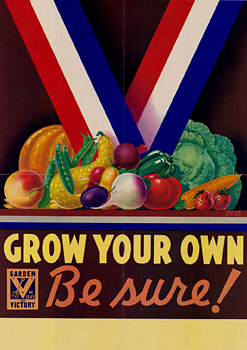
Grow Your Own Victory Garden Poster, 1945The Victory Garden concept returned during World War II. North Dakota’s effort was carefully organized from the Governor’s office. The Governor’s office engaged leaders for three branches of the War Garden effort. The State Defense Council led the Village and City Individual Gardens; the State USDA War Board led the Farm Gardens; the League of North Dakota Municipalities led the effort for community gardens. At the next level, Local Defense Councils, County Agents, and city governance agencies worked together to distribute information and conduct local meetings. At the neighborhood level, local Block Leaders (part of the Civil Defense organization), neighborhood leaders, and local businessmen and service clubs kept individuals informed about Victory Garden programs and reported to their superiors on local results. A more practical understanding of the system is to note that there were Victory Garden committees in every town and every township in the state. For instance, Barnes County had 1 county committee, 41 township committees, and 11 town committees. Most of the committees consisted of three people and both men and women served on the committee. Notably there was only a single major entity without a committee which was, oddly enough, Bismarck.
The 1943 report was filed with Governor Moses on December 20, 1943. Harry Graves, Extension horticulturist at NDAC, signed the letter of transmittal. He noted that all figures were estimates, and explained one important discrepancy: 1943 saw a 42% increase in seed ordered over 1942, but only a 25% increase in total garden produce. The reason is that new gardeners, he stated, “tend to over-buy.”




